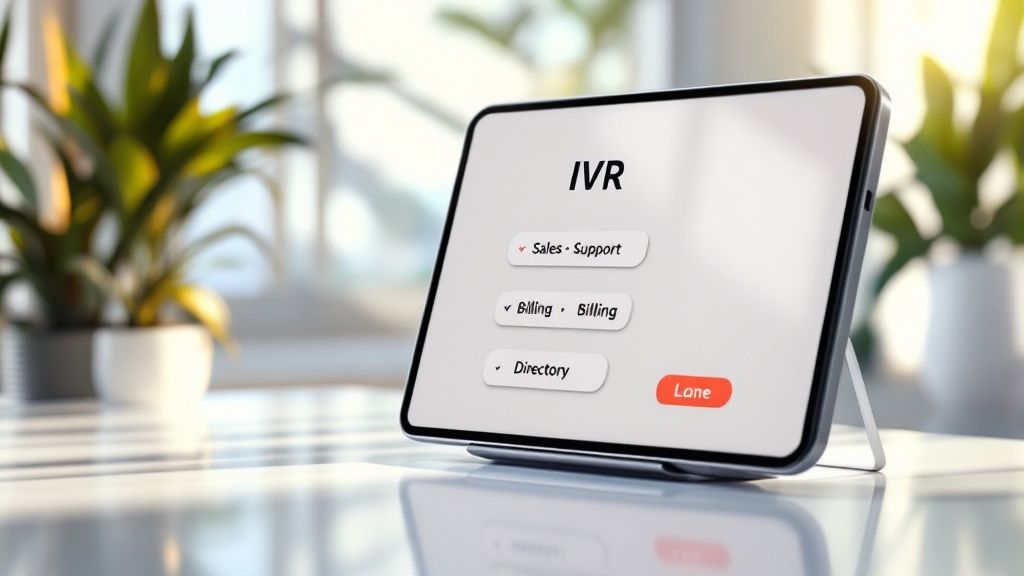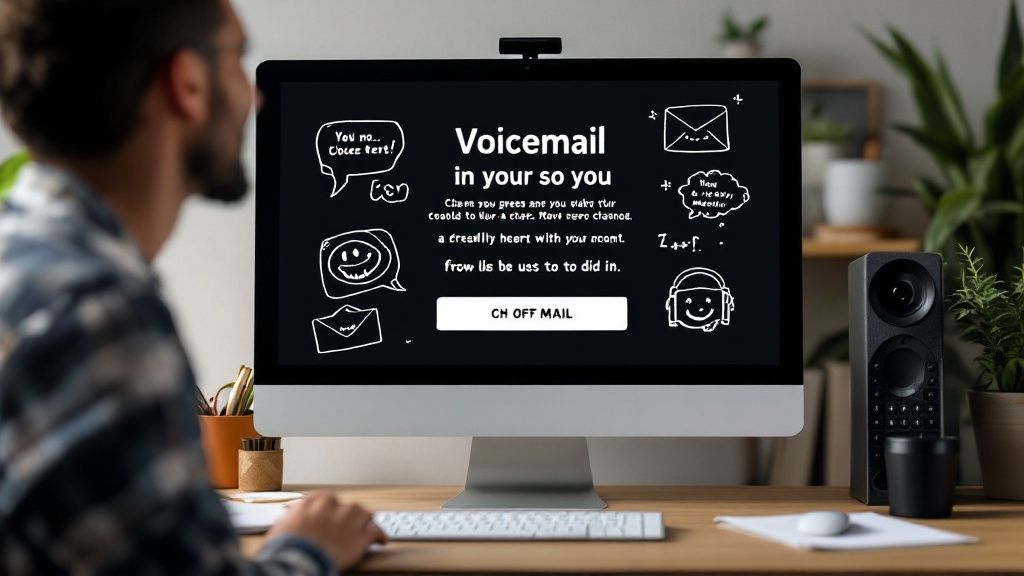Why Your Business Voicemail Greeting Matters
Your voicemail greeting is often the first interaction a potential client has with your business. A professional voicemail greeting can make or break that first impression. This article provides eight effective voicemail greetings for business, offering examples to enhance your image, convey important information, and improve customer satisfaction. Learn how to craft personalized, informative, and brand-consistent voicemail greetings for business that leave a positive impact, whether you're a mortgage broker, real estate agent, property manager, tradesperson, or other small business owner.
1. Personalized Professional Greeting
The Personalized Professional Greeting is a highly effective strategy for voicemail greetings for business, especially for professionals in client-facing roles. This approach blends professionalism with a personal touch, creating a more engaging and positive experience for the caller. It involves crafting a greeting that includes your name, title, and a brief, personalized message, all while maintaining a professional tone. This method helps establish rapport and assures callers they've reached the right person. This type of greeting is particularly valuable for businesses in the AU region, where strong client relationships are crucial.

For professionals like mortgage brokers, real estate agents, property managers, trades professionals, and small business owners, this personalized approach can significantly enhance client interactions. It's a powerful way to build trust and project competence, even when you're unavailable to answer the phone directly. Features of this type of greeting include your personal name and title, a professional yet personable tone, often mentioning the company name for brand reinforcement, and a concise length, typically 20-30 seconds. You can learn more about Personalized Professional Greeting to further understand its benefits.
Example:
"Hello, you've reached Sarah Johnson, Marketing Director at Acme Solutions. I'm currently unavailable to answer your call, but your message is important to me. Please leave your name, number, and a brief message detailing your enquiry, and I'll return your call within 24 business hours. For urgent matters, please contact our main office at 555-123-4567. Thank you for calling Acme Solutions."
Tips for Implementation:
- Brevity is Key: Keep your greeting under 30 seconds to respect the caller's time.
- Clarity and Pace: Speak clearly and at a moderate pace. Avoid rushing or speaking too slowly.
- Full Name and Title: Clearly state your full name and title for clarity and professionalism.
- Alternative Contact: Provide an alternative contact number for urgent inquiries, ensuring clients can receive timely assistance.
- Warm Tone: Smile while recording to project a friendly and approachable tone.
- Regular Updates: Update your greeting to reflect changes in your schedule or responsibilities. For instance, if you're out of the office for an extended period, mention this in your greeting.
Pros:
- Creates a Personal Connection: A personalized greeting makes callers feel more valued and less like they're talking to a machine.
- Conveys Professionalism and Competence: Including your title reinforces your expertise and builds credibility.
- Confirmation and Comfort: Callers know they've reached the correct person, increasing their comfort level.
- Increased Trust: A personal touch fosters trust, particularly crucial for businesses relying on strong client relationships.
Cons:
- Outdated Information: Greetings can become outdated if responsibilities or schedules change frequently.
- Balancing Personal and Professional: Requires careful wording to maintain professionalism while injecting personality.
- Frequent Updates: May require more frequent updates than a generic voicemail greeting.
The Personalized Professional Greeting earns its place on this list because it offers a compelling balance between professionalism and approachability. It's a valuable tool for Australian businesses aiming to build strong client relationships and provide excellent customer service. This method is particularly relevant for professionals who frequently communicate with clients, such as those in the real estate, finance, and trade industries. It allows them to make a positive impression even when they can't answer the phone directly.
2. Brief and Direct Greeting
In the fast-paced Australian business world, efficiency is key. A brief and direct voicemail greeting is a minimalist approach to voicemail greetings for business that prioritizes respecting the caller's time. It quickly identifies who they've reached and provides clear instructions for next steps, without unnecessary details or pleasantries. This method is particularly effective for professionals who receive a high volume of calls and need to manage their time efficiently.
This type of greeting is extremely concise, typically lasting only 10-15 seconds. It immediately identifies the person or department the caller has reached and provides a clear call-to-action. No time is wasted on lengthy greetings or company mottos. The core components are: immediate identification, a request for the caller's information, and a brief statement regarding call-back expectations. This streamlined approach ensures the caller gets the essential information quickly and can leave a message without delay.
Example:
"This is John Smith, sales department. Please leave your name, number, and request after the tone. I'll call back within four hours."
Pros:
- Respects caller's time: Gets straight to the point, avoiding unnecessary fluff.
- Reduces frustration for repeat callers: Especially beneficial for clients or colleagues who frequently contact you.
- Increases likelihood message will be listened to completely: Short and to-the-point messages are more likely to be heard in their entirety.
- Projects efficiency and organization: Conveys a professional and focused image.
Cons:
- Can seem impersonal or abrupt: The lack of pleasantries can sometimes be perceived as cold, particularly for first-time callers.
- Misses opportunity to build rapport: A more personalized greeting can create a warmer, more welcoming experience.
- May not include enough information for first-time callers: Consider including your business name if your name alone isn't sufficient for identification.
Tips for Creating a Brief and Direct Voicemail Greeting:
- Use a warm, assertive tone to avoid sounding brusque: While brevity is key, maintaining a friendly tone prevents the message from sounding rude.
- Include essential information only: Stick to your name, department (if applicable), and instructions for leaving a message.
- Set clear expectations for call-back time: Letting callers know when to expect a return call manages their expectations and reduces anxiety.
- Review for clarity – every word should serve a purpose: Edit out any unnecessary words or phrases.
- Maintain consistent volume throughout the message: Ensure the entire message is easily audible.
This style of voicemail greeting is particularly popular amongst professionals in fast-paced industries where time is of the essence, such as tech companies like Apple and Google, high-volume sales teams, legal professionals, and financial services professionals. It’s also ideal for mortgage brokers, real estate agents, property managers, trades professionals, and small business owners in Australia who need to manage a high volume of calls efficiently.
If you're also looking for ways to streamline your other communication channels and ensure prompt replies, especially during peak hours or when out of office, consider using automated email responses to manage incoming email inquiries efficiently. This can complement your brief and direct voicemail strategy for a cohesive and efficient communication system. Source: Automated Email Response Examples to Boost Efficiency from TriageFlow
This brief and direct voicemail greeting deserves its place on this list because it offers a highly effective way to manage communications professionally and efficiently. By prioritizing clarity and conciseness, it ensures that callers can quickly leave a message and get on with their day, reflecting positively on your business and your commitment to client service.
3. Customer Service-Focused Greeting
In the fast-paced Australian business landscape, exceptional customer service is paramount. A customer service-focused voicemail greeting is designed specifically to prioritize the customer experience, even when you're unavailable to answer the phone directly. This approach emphasizes helpfulness, provides alternative contact options, and reassures callers about response times, minimizing frustration and demonstrating a commitment to customer care. This type of greeting is particularly beneficial for businesses that rely on strong customer relationships, such as mortgage brokers, real estate agents, property managers, trades professionals, and other small business owners.

This greeting style offers several key features: a clear emphasis on customer support, multiple contact alternatives (like email, SMS, or online chat), a defined expected response time, acknowledgment of the customer's importance, and, if applicable, emergency contact information. These features work together to create a positive impression even before a conversation takes place.
Example:
"Thank you for calling [Your Business Name]. This is [Your Name/Department]. I'm currently assisting other clients, but your call is important to us. Please leave your name, number, and a brief message outlining your enquiry. I will return your call within [Timeframe – e.g., 2 business hours/the end of the day]. For immediate assistance, you can text this number, email us at [Your Email Address], or visit our website at [Your Website Address] for live chat support. We appreciate your business."
Pros:
- Improved Customer Satisfaction: Even when unavailable, this greeting reassures customers that their call matters.
- Reduced Call-Backs: Providing alternatives allows customers to choose the most convenient contact method.
- Managed Expectations: Clear timelines prevent uncertainty and frustration.
- Demonstrates Customer-Centric Values: This approach showcases your commitment to excellent service.
Cons:
- Length: These greetings are often longer than standard voicemail messages.
- Maintenance: Alternative contact details must be kept up-to-date.
- Potential for Misinterpretation: Promising quick responses can create an expectation of immediate service, which may not always be feasible.
Tips for Implementation:
- Regular Updates: Ensure all alternative contact methods are current and functional. Test them regularly.
- Realistic Timeframes: Promise response times you can consistently deliver.
- Emergency Protocol: If relevant, include instructions for urgent situations.
- Warm and Helpful Tone: Use a friendly and professional voice to convey sincerity.
- Target Your Audience: Tailor your message to resonate with your specific clientele (e.g., mortgage brokers might mention specific loan-related queries).
When to Use This Approach:
This style of voicemail greeting for business is ideal for professionals in client-facing roles where responsiveness and accessibility are crucial. This includes mortgage brokers, real estate agents, property managers, trades professionals, and other small business owners who need to maintain strong customer relationships. By prioritizing customer service even when unavailable, these professionals can build trust, enhance their reputation, and ultimately drive business success within the competitive AU market. This greeting deserves its place on this list due to its proven effectiveness in improving customer satisfaction and managing expectations, contributing significantly to a positive brand image.
4. Informational/Educational Greeting
An Informational/Educational Greeting goes beyond simply stating your unavailability. It transforms your voicemail into a valuable resource for callers by proactively providing useful information. This approach can significantly enhance the caller experience, even when you're unable to answer directly. This type of voicemail greeting is particularly valuable for busy professionals in Australia like mortgage brokers, real estate agents, property managers, trades professionals, and small business owners who often receive numerous calls regarding common queries.
This strategy works by anticipating callers' needs and addressing them preemptively. By incorporating frequently asked questions (FAQs), current promotions, business hours, or other relevant details into your greeting, you can empower callers with the information they seek, often eliminating the need for them to leave a message and wait for a callback. Learn more about Informational/Educational Greeting
Examples of Successful Implementation:
-
Mortgage Broker: "Thank you for calling [Your Name] at [Your Brokerage]. I’m currently unavailable. Interest rates are fluctuating daily, so for the most up-to-date information please visit our website at [Your Website Address]. For current fixed rates, press 1. For variable rates, press 2. If you’d still like to speak with me directly, please leave your name and number after the tone, along with a brief description of your inquiry and I’ll return your call as soon as possible."
-
Real Estate Agent: "Hello, you've reached [Your Name] at [Your Agency]. I'm currently showing a property. For information on our current listings, including open house times, please visit [Your Website Address]. If you are inquiring about a specific property, please leave the address in your message along with your name and number and I will return your call shortly."
-
Trades Professional (Plumber): "Hi, you've reached [Your Business Name]. I'm currently out on a job. Our standard service call fee within the metro area is [Dollar Amount]. For emergency after-hours service, please press 1. For all other inquiries, please leave your name, number, and a brief message after the tone and I'll return your call as soon as possible."
Actionable Tips:
- Update Regularly: Keep information current. Weekly updates, or more frequent updates when circumstances change (like interest rate adjustments for mortgage brokers), are essential.
- Focus on Key Information: Prioritize information most callers are seeking. What questions do you get asked most often? Address those first.
- Be Concise and Relevant: Get straight to the point. Avoid jargon and keep the educational content brief and easy to understand.
- Consider Seasonality: Adapt your greeting based on seasonal demands. For example, during peak seasons for trades professionals, you may want to highlight booking lead times.
- Balance Information with Brevity: Aim for a greeting length of 30-45 seconds. While longer than a standard greeting, it shouldn’t be so long that it frustrates callers.
Pros:
- Adds value to the caller’s waiting time.
- May answer the caller's question, avoiding a callback.
- Presents the company/individual as helpful and knowledgeable.
- Can reduce return call workload.
Cons:
- Requires regular updates to maintain accuracy.
- Longer duration may deter callers in a hurry.
- Requires careful planning to include truly useful information.
When and Why to Use This Approach:
This method is especially effective for businesses or individuals who:
- Receive frequent calls about the same topics.
- Have regularly changing information to share (e.g., promotions, rates, availability).
- Want to project an image of professionalism and efficiency.
The Informational/Educational Greeting earns its place on this list because it offers a strategic way to leverage your voicemail as a powerful communication tool. By proactively providing relevant information, you can improve customer service, streamline communication, and position yourself as a valuable resource in your industry. This is particularly beneficial in the fast-paced Australian market, where clients value efficiency and accessible information.
5. Automated Menu-Style Greeting
For businesses handling a high volume of calls or those with multiple departments, an automated menu-style greeting, also known as an IVR (Interactive Voice Response) system, can be a highly effective way to manage communications. This sophisticated approach uses a pre-recorded message to guide callers through a menu of options, directing them to the appropriate extension or department based on their selection. This streamlines the call handling process, ensuring that callers quickly reach the right person or resource. This type of voicemail greeting is particularly beneficial for businesses in Australia looking to project a professional and organized image while improving overall efficiency.

This method deserves a place on this list due to its ability to significantly improve call handling, especially for busy businesses. Features such as automated routing, diverse caller need handling, and the option for a live person make it a valuable tool for enhancing customer experience and internal operations. Imagine a property management company dealing with tenant inquiries, maintenance requests, and prospective renter calls. An automated menu can efficiently filter and direct these calls, saving valuable time for both the staff and the callers.
Example:
"Thank you for calling [Your Business Name]. If you know your party's extension, you may enter it now. For leasing inquiries, press 1. For maintenance requests, press 2. For accounts payable, press 3. For general inquiries, press 4. To speak with our receptionist, press 0 or stay on the line."
Pros:
- Efficiently directs calls: Reduces time spent transferring calls and ensures callers reach the correct department quickly.
- Reduces misdirected messages: Minimizes the chances of messages ending up in the wrong inbox.
- Offers self-service options: Provides callers with immediate access to information like business hours, location, or FAQs, freeing up staff for more complex tasks.
- Professional image: Projects a sophisticated and organized image of your business to callers.
- 24/7 availability: Can handle inquiries and route calls even outside of business hours.
Cons:
- Potential for caller frustration: Overly complex menus can confuse and frustrate callers.
- Technology investment: Requires investment in an IVR system, which can be a significant cost for smaller businesses.
- Requires careful design: Menu options need to be carefully planned and structured to ensure clarity and ease of use.
- Can feel impersonal: Some callers may prefer a more personal touch than an automated system.
Tips for Effective Implementation:
- Limit choices: Keep the main menu to a maximum of five options to avoid overwhelming callers.
- Prioritize frequent options: Place the most frequently requested options first in the menu.
- Always offer a live option: Ensure callers can always choose to speak to a real person.
- Regular testing: Test the system regularly from a caller's perspective to identify and address any issues.
- Keep it brief: Aim for a maximum of 60 seconds for a caller to reach a human.
- Update prompts: Keep prompts up-to-date with staff changes, service updates, or holiday hours.
When to Use This Approach:
This style of voicemail greeting is particularly suitable for:
- Mortgage brokers handling a high volume of loan inquiries and needing to route them to specific loan officers.
- Real estate agents managing inquiries about multiple properties or different aspects of the real estate process (sales, rentals, property management).
- Property managers dealing with tenant inquiries, maintenance requests, and owner communications.
- Small business owners with multiple employees or departments, looking to streamline communication and improve efficiency.
- Trades professionals managing appointments, quotes, and customer inquiries for different types of services.
By following these tips, you can leverage the power of an automated menu-style greeting to improve communication flow, enhance your professional image, and provide a better overall experience for your callers in Australia. This, in turn, can contribute to improved client satisfaction and increased business efficiency, making it a valuable asset for any business dealing with a significant volume of calls.
6. Brand-Consistent Greeting
For businesses looking to create a cohesive customer experience, a brand-consistent voicemail greeting is a powerful tool. This approach to voicemail greetings for business prioritizes aligning your message with your company's brand voice, values, and overall messaging. It ensures that every customer touchpoint, even your voicemail, reinforces your brand identity. This is particularly important for Australian businesses operating in competitive markets like mortgage broking, real estate, property management, and trades, where differentiation is key.
How it Works:
A brand-consistent greeting goes beyond simply stating your company name. It weaves in elements of your brand personality, using language, tone, and messaging that mirrors your marketing materials and overall brand image. This might include incorporating company slogans, taglines, or even snippets of your mission statement. For example, a real estate agent might use their tagline focused on community or personalized service in their greeting. A trades professional known for speed and efficiency could reflect that in the tone and wording of their message.
Features:
- Incorporates Brand Elements: Uses company slogans, taglines, or mission statements.
- Consistent Language: Employs language consistent with other marketing materials.
- Branded Sound: May include branded sound elements or music (if appropriate).
- Reinforces Brand Attributes: Uses word choice and tone to reinforce key brand attributes.
- Professional Quality: Often professionally recorded for consistent quality and clarity.
Examples:
- "Thanks for calling Sunshine Bakery, where we make life sweeter one bite at a time! Our team is currently creating delicious moments for other customers and can't come to the phone. Leave us a message with your name and number, and we'll get back to you faster than our cookies disappear from the cooling rack – usually within 2 hours during business days. Have a sunshine-filled day!"
- "G'day, you've reached Aussie Electrical. We're sparking solutions for all your electrical needs. We're currently out powering up other homes and businesses, so please leave a message with your name and number, and we'll get back to you within the day. Cheers!"
Pros:
- Brand Recognition: Strengthens brand recognition and recall.
- Cohesive Experience: Creates a consistent customer experience across all touchpoints.
- Differentiation: Sets your business apart from competitors through a unique brand voice.
- Reinforced Messaging: Reinforces key marketing messages, even during routine interactions.
Cons:
- Sounding Scripted: Can sound overly scripted or corporate if poorly executed.
- Marketing Coordination: Requires coordination with your marketing department (if applicable).
- Updates Required: May need updates when brand messaging changes.
- Caller Convenience: Could prioritize branding over providing quick, concise information for the caller.
Tips for Implementation:
- Collaborate with Marketing: Work with your marketing team (or consultant) to ensure brand alignment.
- Balance is Key: Balance brand elements with practical information like your business hours and how quickly callers can expect a return call.
- Clarity is Paramount: Use your brand voice without sacrificing clarity or conciseness.
- Professional Recording: Consider having your message professionally recorded for consistent quality.
- Keep it Current: Update your greeting when brand positioning or key messages change.
Why This Greeting Deserves Its Place on the List:
In a crowded marketplace, standing out is essential. A brand-consistent voicemail greeting elevates a mundane interaction into a brand-building opportunity, reinforcing your identity and leaving a lasting impression on potential clients. This is especially valuable for Australian businesses targeting specific demographics, such as mortgage brokers connecting with first-time homebuyers or property managers building trust with landlords. Learn more about Brand-Consistent Greeting
When to Use This Approach:
This approach is particularly beneficial for businesses with established brand guidelines and a strong focus on customer experience. If you’re a mortgage broker, real estate agent, property manager, trades professional, or small business owner seeking to build a recognizable brand, a brand-consistent voicemail greeting is a valuable asset in your communication toolkit. It shows you pay attention to detail and strengthens your brand presence in every interaction.
7. Seasonal or Topical Greeting
A Seasonal or Topical Greeting is a dynamic approach to voicemail greetings for business, changing regularly to reflect current events, holidays, company announcements, or important information relevant to your callers. This type of greeting keeps the voicemail experience fresh for repeat clients while projecting an image of an attentive, up-to-date, and actively managed business. This is particularly beneficial for businesses in Australia where seasonal changes and holidays can significantly impact operations.
How it Works:
This strategy involves updating your voicemail greeting on a set schedule – weekly, monthly, or seasonally – to incorporate timely information. This could include acknowledging a public holiday, mentioning a special promotion, announcing an upcoming event, or addressing recent market developments that might affect your clients. For example, a mortgage broker might mention current interest rate trends, while a real estate agent could highlight recent sales in a particular suburb.
Examples of Successful Implementation:
- "Hello, you've reached John Smith at Aussie Home Loans. Today is Tuesday, October 24th. We're currently experiencing high call volumes due to the Spring property rush. Please leave your name, number, and a brief message, and I'll return your call as soon as possible. For urgent enquiries, please visit our website at aussiehomeloans.com.au for frequently asked questions." (Example for a mortgage broker during a busy period).
- "G'day, you've reached Sarah Jones at Coastal Property Management. It's Monday, December 18th, and our office will be closed from December 24th to January 2nd for the Christmas and New Year period. For urgent maintenance requests during this time, please contact our emergency line at 04XX XXX XXX. Otherwise, please leave your name and number, and I’ll get back to you when we reopen. Have a safe and happy holiday season!" (Example for a property manager during the holiday season).
Actionable Tips for Australian Businesses:
- Set calendar reminders: Schedule regular updates to avoid your greeting becoming outdated.
- Create a template: Develop a standard greeting with designated slots for timely updates. This ensures consistency while making updates quick and easy.
- Avoid overly specific time references: Instead of "I'm out of the office today," consider "I'm currently unavailable."
- Assign responsibility: Delegate voicemail greeting updates to a specific team member to ensure accountability.
- Keep a log: Track previous greetings to avoid repeating information and ensure consistent messaging.
When and Why to Use This Approach:
Seasonal or Topical Greetings are particularly effective for businesses that experience fluctuations in activity due to seasonal changes, market trends, or specific events. This includes:
- Mortgage Brokers: Addressing interest rate changes or special offers.
- Real Estate Agents: Highlighting market trends, new listings, or open house schedules.
- Property Managers: Communicating holiday closures, maintenance updates, or important notices.
- Trades Professionals: Announcing special offers, seasonal services (e.g., winter plumbing checks), or holiday availability.
- Small Business Owners: Promoting sales, new products, or changes in operating hours.
Pros:
- Demonstrates attentiveness and current operational status.
- Keeps the experience fresh for frequent callers.
- Can address seasonal concerns or opportunities proactively.
- Shows that communication systems are actively maintained.
Cons:
- Requires regular updates and maintenance.
- Can become outdated quickly if not monitored.
- Needs careful planning to maintain professionalism.
- Can be time-consuming to change frequently.
This type of voicemail greeting deserves its place in the list because it provides a dynamic and engaging experience for callers, showcasing your business's proactive approach to communication. By implementing these tips, you can effectively leverage Seasonal or Topical Greetings to enhance your professional image and improve client communication.
8. Humorous or Creative Greeting
Want to make your business voicemail greetings memorable and inject a bit of personality? A humorous or creative greeting can be just the ticket. This distinctive approach uses appropriate humour, creativity, or a dash of your own personality to create a positive caller experience. While maintaining professionalism, it incorporates elements that surprise, entertain, or delight callers, making your business stand out from competitors who rely on standard, often dull, voicemail greetings. This approach is particularly useful for businesses wanting to project a friendly, approachable image.

Humorous or creative greetings often incorporate wordplay, metaphors, or unexpected elements that align with the company culture and personality. The key is to inject personality without sacrificing professionalism. Even with a creative approach, you must still include all the necessary information, such as your name, business name, and how the caller can reach you. The goal is to be memorably different from standard corporate greetings, leaving a lasting positive impression. This can turn the potentially negative experience of reaching a voicemail into a positive one. Think of it as an opportunity to showcase your brand's personality even when you can't answer the phone.
Examples for Australian Businesses:
-
Real Estate Agent: "G'day, you've reached [Your Name] at [Agency Name]. I'm currently out showing off some stunning Aussie properties, but leave your details and a brief description of your dream home (beachfront mansion or cosy cottage?), and I'll be in touch quicker than you can say 'sold!'."
-
Trades Professional (Plumber): "Crikey! You've reached [Your Name] at [Business Name]. I'm currently wrestling with a leaky tap or two, but leave your name, number, and a description of your plumbing predicament, and I'll be back to you before you can say 'g'day'."
Tips for Creating an Effective Humorous or Creative Greeting:
- Know your audience: Ensure the humour is appropriate for your industry and client base. What works for a tech startup might not work for a mortgage broker.
- Test it out: Play your greeting for a diverse group of people before implementing it to get feedback.
- Clarity is key: Balance creativity with clarity – callers should still get the necessary information easily.
- Brand consistency: Consider your brand's overall tone and ensure your greeting aligns with it.
- Play it safe: When in doubt, err on the side of professionalism with just a touch of personality.
Pros:
- Creates a positive, memorable impression.
- Humanises the business relationship.
- Differentiates your business from competitors.
- Can turn an interruption (an unavailable call) into a positive experience.
- Authentically reflects company culture.
Cons:
- Not appropriate for all industries or audiences (e.g., legal or financial services might require a more formal approach).
- Risk of seeming unprofessional if poorly executed.
- Humour is subjective and may not appeal to all callers.
- May need to be toned down for certain client segments.
This method deserves its place on this list because it offers a powerful way to connect with callers on a more personal level, enhance your brand image, and make your business more memorable. While it requires careful consideration and execution, a well-crafted humorous or creative voicemail greeting can be a valuable asset for businesses in the AU region looking to stand out from the crowd. Businesses like Southwest Airlines and Zappos have successfully used this tactic to build a strong brand identity, demonstrating the potential effectiveness of this approach.
8-Point Voicemail Greeting Strategy Comparison
| Strategy Title | Implementation Complexity 🔄 | Resource Requirements ⚡ | Expected Outcomes 📊 | Ideal Use Cases 💡 | Key Advantages ⭐ |
|---|---|---|---|---|---|
| Personalized Professional Greeting | Moderate – requires balanced, periodically updated recording | Medium – professional recording and updates | Builds personal rapport and reinforces brand identity | Professional services and relationship-driven industries | Enhances connection while maintaining professionalism |
| Brief and Direct Greeting | Simple – concise message with minimal details | Low – minimal setup and regular practice | Efficient call routing and clear information delivery | High-volume environments and tech or sales teams | Respects caller's time with focused clarity |
| Customer Service-Focused Greeting | Moderate – includes alternative contacts and clear timelines | Medium – needs up-to-date contact alternatives | Improves customer satisfaction and sets realistic response expectations | Customer-centric businesses where support and care are pivotal | Demonstrates care and manages expectations effectively |
| Informational/Educational Greeting | Moderate – careful planning and frequent updates are required | Medium – requires regular content updates | Provides useful information that may pre-answer common inquiries | Departments receiving repetitive inquiries (HR, IT, customer care) | Adds proactive value by educating callers |
| Automated Menu-Style Greeting | High – involves IVR system design and clear routing strategies | High – investment in technology and design | Streamlines call routing and offers 24/7 self-service options | Large, multi-department organizations and high-volume call centers | Increases efficiency with automated, organized routing |
| Brand-Consistent Greeting | Moderate – needs coordination with marketing for alignment | Medium – professionally recorded messaging | Strengthens brand identity and provides cohesive customer experience | Companies with strong, distinctive brand identities | Reinforces marketing messages and brand recognition |
| Seasonal or Topical Greeting | Moderate-high – requires regular, timely updates | Medium – periodic content refreshes | Keeps communication current and engaging with timely updates | Event-driven businesses or those with seasonal focuses | Reflects current events and maintains freshness |
| Humorous or Creative Greeting | Moderate – balance between creativity and clarity needed | Low to Medium – creative input with minimal tech | Differentiates brand personality and creates a memorable impression | Creative agencies, startups, and companies with casual cultures | Humanizes interactions with a memorable, playful twist |
Choosing the Right Voicemail Greeting for Your Business
Your voicemail greeting is often the first impression a client or colleague has of your business. This article explored a range of voicemail greetings for business, from the classic professional greeting to more creative options, including incorporating seasonal messages or leveraging an automated menu. Key takeaways include keeping your greeting concise and informative, ensuring it reflects your brand identity, and tailoring it to your target audience. Whether you're a mortgage broker in Melbourne, a real estate agent in Sydney, or a trades professional in Perth, the right voicemail greeting can significantly enhance your professional image and improve client communication. Mastering these approaches isn't just about etiquette; it's about optimising every touchpoint with your clients, ensuring a positive and efficient experience from the first contact.
A well-crafted voicemail greeting demonstrates professionalism and reassures callers that their message is valued. By implementing the strategies outlined in this article, you can transform your voicemail from a simple answering machine message into a powerful tool that strengthens your brand and streamlines your communication process. Want to take your call and voicemail management to the next level, saving time and boosting efficiency? Explore OnSilent (https://onsilent.com), a tool designed to help businesses like yours optimise their communication workflow, offering innovative solutions beyond just voicemail greetings for business. See how OnSilent can help you project a professional image and improve client communication today.


